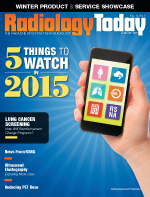 January 2015
January 2015
Radiology Billing and Coding: Postreduction X-rays
By Erica T. Cousin, CPC, CPC-I, and John Verhovshek, CPC
Radiology Today
Vol. 16 No. 1 P. 7
Postreduction X-rays—those taken after manipulation and casting have occurred—are commonly performed to confirm alignment of the bone. Proper coding and billing for these additional films in the outpatient setting depends on several factors, including the following:
• Does the same provider who interpreted the initial film also read the postreduction X-ray, or does a different provider read the postreduction film?
• Is the number of pre- and postreduction views the same or different?
• Who is the payer?
Same Provider, Same Number of Views
When the same provider reads the same number of pre- and postreduction views, he or she will report two units of the appropriate CPT code, and append modifier 76, "repeat procedure or service by same physician or other qualified health care professional" to the second unit.
For example: A provider interprets a prereduction X-ray of the elbow with a minimum of three views (73080, "radiologic examination, elbow; complete, minimum of three views"), followed by a postreduction X-ray of the elbow with the same number of views. The proper coding is 73080, 73080-76.
Same Provider, Different Number of Views
If the same provider reads both the pre- and postreduction films, but the prereduction X-ray differs from the postreduction X-ray (eg, three views prereduction and two views postreduction), separately report the appropriate CPT code for each X-ray and append modifier 59, "distinct procedural service" to the postproduction X-ray code.
For example, a provider interprets a prereduction X-ray of the elbow with a minimum of three views (73080), followed by a postreduction X-ray of the elbow with two views (73070, "radiologic examination, elbow; 2 views"). In this case, you would report 73080, 73070-59.
An exception to the above rule applies for some Medicaid payers, who will require you to report the second procedure with modifier 76 when the same provider interprets both films, regardless of the number of views; for example, see the North Carolina Medicaid Modifier Special Bulletin available at www.ncdhhs.gov/dma/bulletin/pdfbulletin/0499spec.pdf. Be sure to verify the proper coding with your Medicaid payer before submitting claims.
Different Provider, Same or Different Number of Views
The coding also changes if a second provider performs the postreduction X-ray and the X-ray orders are the same, pre- and postreduction, such as three views for each. Under these circumstances, append modifier 77, "repeat procedure or service by another physician or other qualified health care professional," to the postreduction X-ray code (eg, 73080 for the first provider, who reads the prereduction X-ray, and 73080-77 for the second provider, who reads the postreduction X-ray).
If a different provider reads the postreduction X-ray and the number of views also changes, you should append modifier 59 to the postreduction code (eg, 73080 for the first provider; 73070-59 for the second).
Additional Modifiers May Apply
In all the circumstances described above, you would also apply any appropriate anatomical modifiers (RT for right side, LT for left side), as necessary, to describe the location at which the X-rays are taken. For example, for three views of the left elbow, you would report 73080-LT.
Additionally, when reporting only the provider's interpretation of the films, you must append modifier 26, "professional component" to all X-ray codes. Only if the provider supplies both the professional and technical components of the service in a nonfacility setting (for instance, by providing the X-rays in her own office, using her own equipment) may he or she report the appropriate CPT code without modifier 26.
As always, you may report X-rays and other radiology services only with a signed order by the treating physician, and only if a separate radiology report is generated. See the Medicare Benefit Policy Manual, chapter 15, section 80.6, available at www.cms.gov/Regulations-and-Guidance/Guidance/Manuals/downloads/bp102c15.pdf, for additional information.
— Erica T. Cousin, CPC, CPC-I, serves on the National Advisory Board for AAPC, Region 3. She manages the central charge review department at Cornerstone Health Care in High Point, North Carolina, and has worked in the health care industry for more than 15 years in various capacities, including management, coding, A/R follow-up, and cash applications.
— John Verhovshek, CPC, is managing editor for AAPC, the nation's largest medical credentialing organization.

